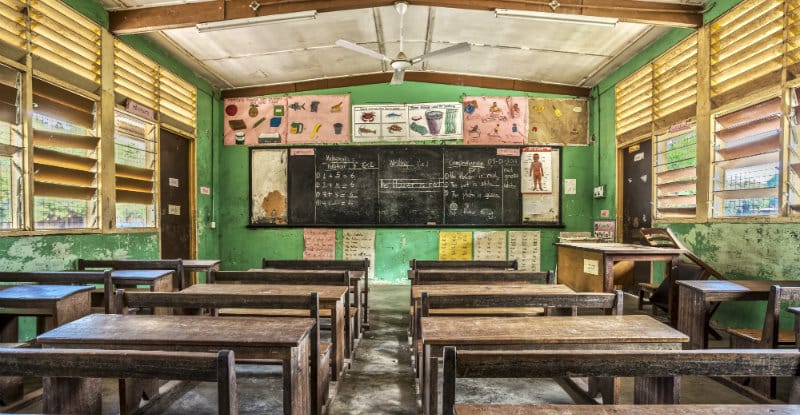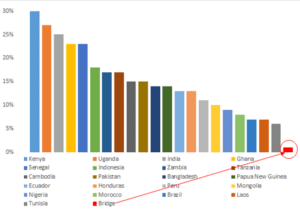Today, 263 million children around the world don’t attend school. Another 330 million, despite being in school, receive subpar education. It’s not that their parents don’t want quality education for their children. Rather, existing solutions are priced far above what they can afford. And the solutions most can afford, many of which are government funded, are so mediocre children are better off without them.
It’s a global education problem – and a prime example of nonconsumption, defined as a large segment of the population that cannot afford to purchase and use existing solutions in the market. To tackle the issue of nonconsumption, countries suffering most from the education crisis must invest in market-creating innovation. It is the investment in, and proliferation of, market-creating innovations in poor countries that leads to economic prosperity. Bridge International Academies (Bridge) is proof.
Bridge, a chain of nursery and primary schools with a mission to deliver affordable education to millions of children in poor countries, is one of the best examples of a market-creating innovation in Africa. If harnessed properly and supported aggressively, Bridge – supported by Bill Gates, Zuckerberg, the World Bank, and several other high-profile institutions and foundations – could have a positive societal impact that far surpasses the popularly celebrated mobile money platform M-PESA.
Despite being less than a decade old and operating in some of the toughest countries in the world, Bridge has already made a tremendous impact. Since 2009, it has built more than 500 schools in India, Kenya, Liberia, Nigeria, and Uganda, and has educated more than 250,000 children. As you read this, there are currently more than 100,000 children receiving a quality education in Bridge schools across those five countries. Teacher absenteeism, a problem so pervasive in poor countries it has been flagged by the World Bank, is a mere one percent at Bridge. The global average monthly cost of a Bridge education is about $7 per month, an amount within the reach of many of Bridge’s consumers. Approximately one new Bridge school is built each month, further broadening its reach.
Transparency International Teacher Absenteeism Survey, 2004-2011 (Data for Bridge is for 2017)
Yet, despite all of the positives, in November 2016, a Ugandan court ordered the closure of 60 Bridge schools, citing allegations of poor hygiene and putting children’s lives at risk. In Liberia, a United Nations rights expert complained that the country’s decision to “outsource its primary education to a private company” is unacceptable. Unfortunately, these complaints are misguided and could cause a devastating shock to an already fragile education system in many poor countries.
Bridge’s solution, while not perfect, far surpasses what many poor country governments can accomplish. Remember, these are countries that struggle to pay salaries of existing public servants. But the gospel of “universal primary education,” promulgated by the United Nations Sustainable Development Goal 4, is now so pervasive that education is not only seen as an absolute necessity, but also as the exclusive responsibility of the government. We forget that now-developed countries did not have this heavy burden when they were poor.
Instead of calling for the closure of Bridge schools, or complaining about the outsourcing of a core function of government (providing education), these actors should learn from – and work with – Bridge. At its core, Bridge represents a model of innovation that is absolutely necessary for poor countries to adopt if they are to escape poverty and catapult to prosperity.
First comes fear, then comes improvement and adaptation
Many of the incumbents in the education sector of poor countries, including teachers, unions, administrators and policymakers, have real and understandable fears. Their beloved sector will likely undergo an unwelcome, but necessary, transformation. However, instead of looking at Bridge as a replacement, they should consider it a complement to the existing under-resourced education system. A complement that could truly transform the education sector in their respective countries – and even create better opportunities for them and for their children.
Consider Ford’s “affordable automobile” innovation with the Model T, which spurred the mass consumption of cars and revolutionized America. In hindsight, we recognize it as a crucial invention, but many during the industry’s nascency did not see it that way. Instead, the automobile was viewed as a “noisier, dirtier, and more dangerous variation of the bicycle.” Their concerns were valid; people lost their lives and limbs while driving and sharing the streets with the automobile. But its value to society was so indisputable that, instead of calling for its demise, we innovated further, improved it, and figured out a way to better integrate it to society. A similar result can happen with Bridge.
Understand, and then challenge
The value Bridge provides is clear. But Bridge, by itself, is not enough. To truly have a transformative impact in the countries where Bridge works, we should challenge it to further integrate its operations. For instance, we should ask Bridge what its plans are for the students that graduate from their programs. How will it radically transform not just primary education, but also other forms of education?
If Bridge were challenged, as opposed to criticized, the organization would rise to the challenge – and it has already begun to. Today,Bridge provides secondary school scholarships for some of its primary school graduates, understanding the value of an excellent primary school education diminishes without access to secondary school. It also started to measure students’ performance on national exams, finding the longer a student is educated at Bridge, the higher the student’s chances of passing. In Kenya, Bridge’s two longest running academies had a 100 percent pass rate for the Kenya Certificate of Primary Education exam.
The reality in poor countries is dire
Aagon Tingba, the Liberian Deputy Minister for Administration in Education, could not have said it better: “Critics say the government should be responsible for our own schools, but in Liberia we simply don’t have the resources to do it ourselves. That is the reality. Liberian children deserve more. Doing nothing was not an option.”
To say Bridge should not be in the business of providing affordable education because that “is the government’s responsibility” is understandable, but incomplete thinking. What happens when many governments cannot afford it?
Bridge is not a perfect organization, but it is an excellent one. We must not mistake perfection with excellence. Considering the constraints Bridge schools operate under and within, the organization has developed an innovation that has already impacted hundreds of thousands of children and tens of thousands of families in some of the poorest countries in the world. That kind of impact, when assessed with any measure of objectivity, is excellent. Instead of calling for its closure, policy makers, innovators, development practitioners, and global development advocates should develop and foster similar innovations.
For more, see:
Stop building schools; stop building water wells; stop building toilets




